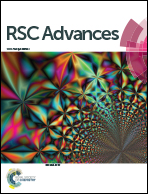Synergistic effects of dopant (Ti or Sn) and oxygen vacancy on the electronic properties of hematite: a DFT investigation†
Abstract
Hematite has been widely studied as one of the most promising photoanodes in the photoelectrochemical decomposition of water. At present, a prevailing strategy of coupling dopant (Ti or Sn) with oxygen vacancies has been proposed by experiment, and effectively improves the photocatalytic activity. In order to clarify the intrinsic reasons for the improvement of the photochemical activity, density functional theory is adopted to calculate the formation mechanism and electronic properties of hematite with doping ions and oxygen vacancies. The result shows that the doped atom is beneficial to the formation of oxygen vacancies in hematite, thus forming a stable structure containing doping ions and oxygen vacancies. Due to the synergistic effects of dopant and oxygen vacancies, the bandgap of hematite decreases, and donor levels are introduced into the bandgap, which lead to the increase of carrier concentration. In the system with doped Ti and oxygen vacancies, donor levels are introduced at 1.47 eV and 1.73 eV below the bottom of the conduction band, respectively. For the case containing Sn and oxygen vacancies, the donor level is introduced at 1.75 eV from the conduction band minimum. Our results elaborate the reasons for the enhancement of carrier densities in terms of electronic structure, and provide some guidance for the future modification of photocatalysts.



 Please wait while we load your content...
Please wait while we load your content...